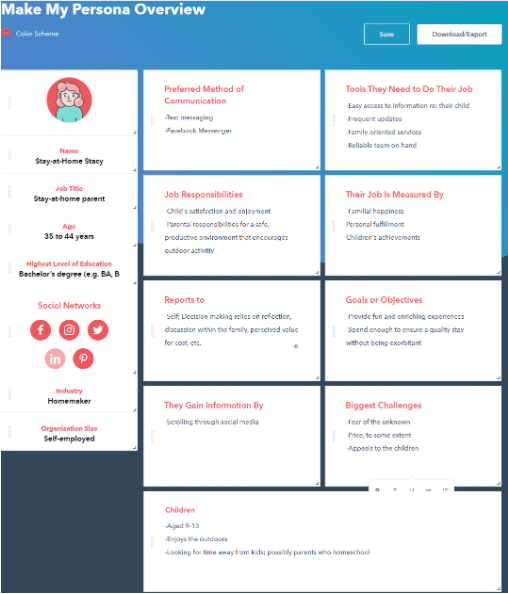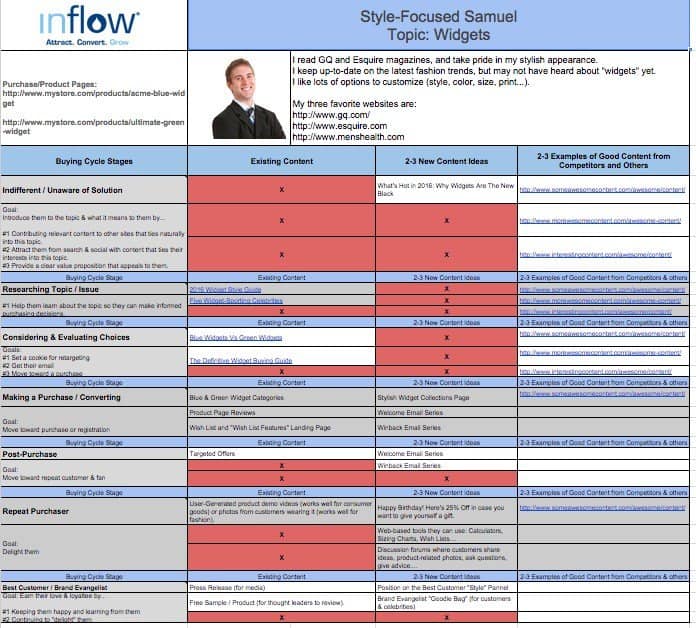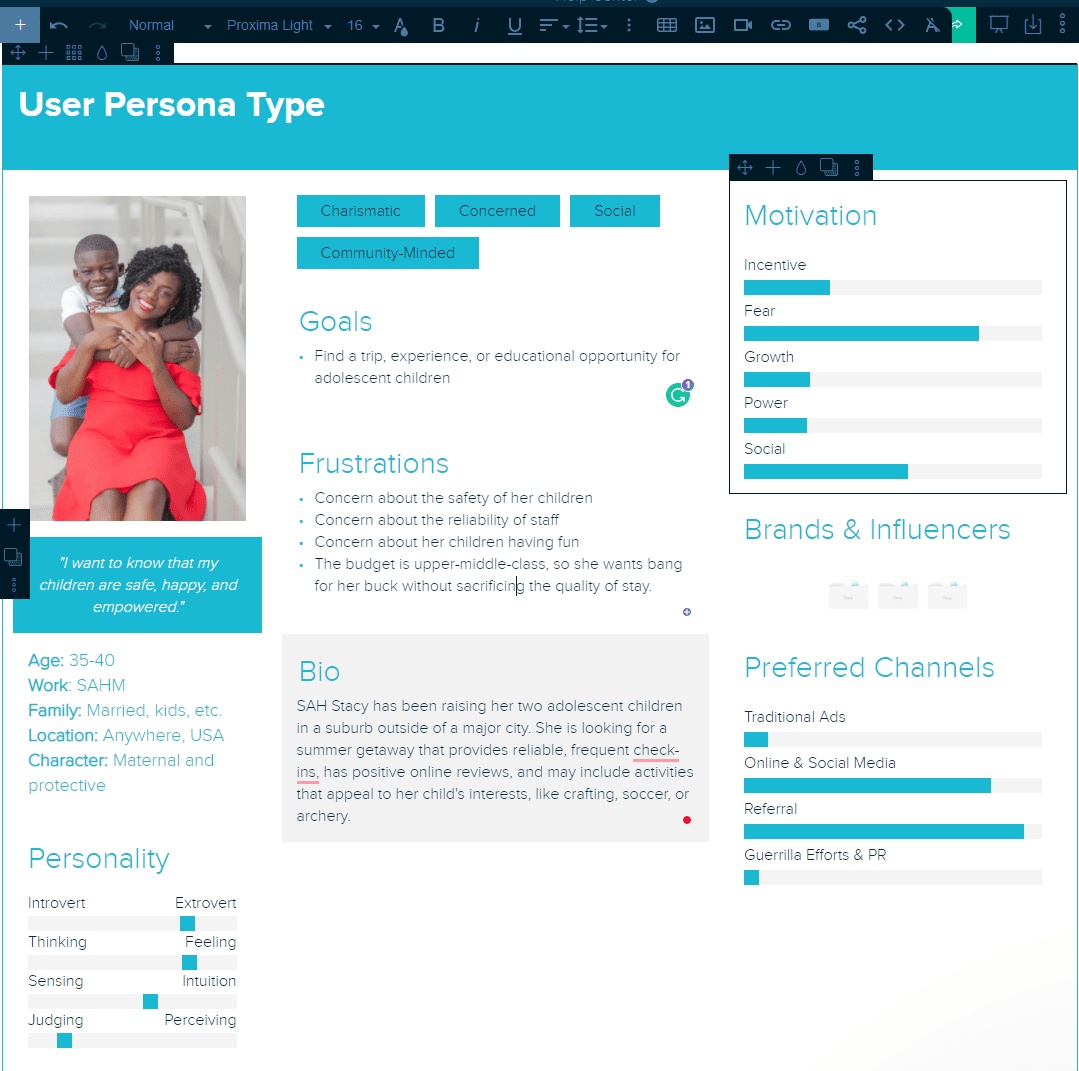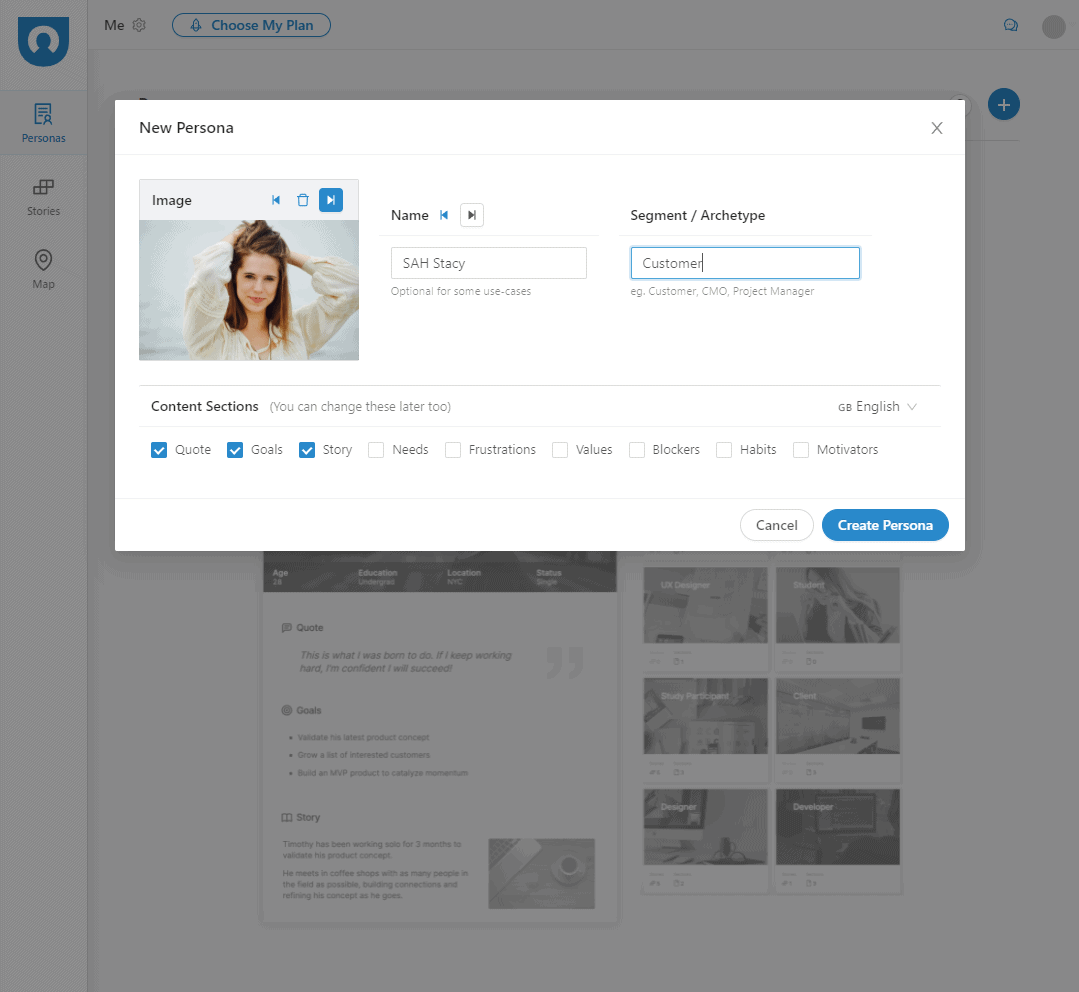The NATIV3 Guide to Building a Buyer Persona

Marketing is a dirty job, but someone’s gotta do it.
Sometimes, it feels like throwing rubber darts at a wall made of Jell-O and crossing your fingers that something will stick.
Other times, it’s as easy as hitting the broad side of a barn.
Positioning yourself in front of the right people at the right time is no easy task. It requires research, empathy, and an open mind ready to listen to what everyone (and we do mean everyone) has to say about your business.
If you don’t have boards, nails, or a project in mind, someone handing you a hammer means you’re going to smack a hole in the wall.
So, let’s run through some of the fundamentals before diving into our user persona template list. `
What is a Buyer Persona?
A buyer persona is a fictional profile of your target audience.
It takes a snapshot of the people you are marketing to and dissects everything about who they are, what they do, and why they would be interested in your business.
Creating personas isn’t just helpful; it’s an absolute necessity. They provide laser-focus to your marketing strategy, giving your team the data they need to stop investing in tactics that won’t bring long-term results.
Let’s say that you sell custom skateboards.
You probably have an idea of who will buy your product (boys under 18) and where you can find them (at a skatepark).
While that information is… technically helpful… it’s also very obvious. The actual value of buyer personas is peeling away those surface-level assumptions to get to the goodies within your typical customer.
Is There a Difference Between Buyer Personas, User Personas, and Customer Personas?
Buyer personas, user personas, and customer personas are all different names for the same process.
We’ll use all three throughout the article.
Why Does a Business Need Buyer Personas?
Just as you wouldn’t wander into the wilderness without a map, it’s irresponsible to pursue an effective marketing strategy without understanding who your customers are both while actively engaged with your business and during their everyday life.
As a small business, we understand how frustrating it is when new jargon hits the marketing world and those afraid of being left behind jump to action, only to find that our hard work isn’t practical.
But creating user persona examples is anything but that. Persona generators are newish, but the concept of mapping out what a customer wants, needs, and struggles with during the buying journey isn’t some newfangled fad.
In fact, a user persona template is just that– a template that you should morph into a solution for your business, campaign, or platform. All of the persona creator software we discuss a little later isn’t a dictated pathway for you to walk, but rather a starting point for better understanding your target groups’ most essential components.
What Kind of Data Do I Need to Create Buyer Personas?
To truly visualize customer experience, you have to speak with the people who are most familiar with it.
Before you create beautiful customer personas, you and your team members will spend some time speaking with existing customers, those in your target market, and reviewing industry-specific insights for information.
Think of the data-gathering phase as a chance to dive into the research, gain context, and conceptualize the final product. In contrast, your individual buyer personas are the summation of all that information into a visually appealing, easy-to-use target for your marketing efforts.
How Do I Gather the Data?
Figuring out where to gather data can feel like an unachievable hurdle, especially if this is your first time, even considering the idea of working with persona generators.
Fortunately, you have an entire toolbox of techniques at your disposal.
Real Customers
Real customers should be your primary source.
According to the Buyer Persona Institute, “There is one proven way to align sales, marketing and product development efforts with the bona fide needs of your buyers, and that is through in-depth interviews with actual buyers.”
By focusing your customer persona creation on real customers, you get to work with people already in the know with your brand, which means that they have already formulated personal criteria for what they love, like, and dislike about the customer journey you provide.
In addition, customers like talking about their experiences with a product, brand, campaign, or situation because it allows them to be heard and understood. They get the opportunity to play a role in solving their pain points and promoting effective customer journey maps for brands they already use.
Essentially, these are the people who exist as living proof that you’re doing something right, and you should eagerly seek to drink from their rich fount of knowledge.
In terms of recommended methods, try for:
- In-person interviews with transparent outlines of the business objectives behind them. Let them know why you’re interested and how it’s going to affect the business’s development.
- Pop-up exit surveys that appear when users navigate away from a page. Use them sparingly, as overkill can become a considerable nuisance. Ask quick, multiple-choice questions, but leave room for direct feedback.
- Email surveys with perks attached. You already have a list of loyal subscribers who care enough not to send you to spam. Annually, send out a survey email that asks for feedback from the previous year and reward folks for participating. Qualtrics, a leading survey management company, has shared a few guidelines for using incentives:
The Ideal Customer
This one might be a little more challenging until you’ve at least drafted a buyer persona template, but no one said the process used to create personas couldn’t be recursive.
Once you have some idea of what you are (and are not) looking for, circle back around to chat with the target audience groups you’ve identified to really hone the edge.
This is where your current marketing is going to come in handy.
Each time you identify a new customer or interested party, reach out directly.
No, seriously, send an actual, human email.
Ask them what led them to your site, what they thought of it, and why they decided to go with your brand. Chat with them about their lifestyles and what problems they are hoping to solve with their purchasing decision. Put them in touch with team members who can further help them along the buying journey, including becoming repeat customers.
Not only are you gathering information more valuable than any Google Analytics data, but you’re also forging lasting relationships with people that are going to play a part in your business development directly.
Sales Team
Now, usually, we don’t recommend sticking too close to home when it comes to gathering customer data because it’s too easy, and thus, tempting to rely on it for the bulk of your research.
That being said, your sales team is probably the richest source of information for your buyer persona endeavors.
They are the people who are toiling away in the proverbial fields, learning what people want to hear and how they want to listen to it. From an insider perspective, that insight into customer preference should be an ingredient in your later marketing strategy, especially once you’ve proven its validity through honest customer feedback.
CRM Journey Map Data
While certainly the least personal resource, CRM journey map data still has its part to play in crafting user personas.
Its usefulness comes from its ability to streamline massive amounts of information into one comprehensible dashboard that you can pull from as necessary.
Again, don’t rely on it more than you do candid customer feedback, but don’t be afraid to cross-reference and reinforce your buyer personas with the quantitative specifics it provides.
Automated Content Inventories
For websites that span hundreds, if not thousands, of pages and subpages, automated content inventories can help you understand the scope of what it is that you’re already offering your customers.
As an example, browsers spend 88% more time on pages that have a video embedded.
How many videos do you have?
What pages are they on?
Is there a correlation between the most-visited pages and those with videos?
Working with online tools such as Google Analytics gives you critical data that reveals behavioral patterns, decision-making processes, and content strategy guidelines that will make your entire company more effective at reaching visitors.
A Quick Start Guide to Create a Customer Persona
Now that you have your data, it’s time to do something with it.
As you work through a user persona template, don’t be afraid to scrap the parts that don’t matter to you or come back to them later in the process.
Your marketing strategy should be an ever-evolving entity, so leave yourself room to grow.
Additionally, this creation process isn’t something that only the CEO or management team should be involved in. Invite the entire team to share in building effective buyer personas.
It’s constructive for getting everyone on the same page as you implement your new marketing strategies.
Segment the Data
Before you dive into building something with your data, you need to chunk it out into more digestible pieces. Otherwise, overwhelm will quickly set in, your buyer personas will be less focused, and your ideal user profiles may begin to overlap.
We find it helpful to sort into some basic categories that can become more specific as you disaggregate information. Look for commonalities in:
- Basic demographics
- Pain points and sales objections
- Lifestyles
- Industry
- Lead source
However, one thing to keep in mind is that over-segregation can cause more problems than it solves.
For example, if you sell a product that helps home gardeners and a different product that allows commercial landscapers, lumping them into one persona doesn’t make much sense.
On the other hand, if you are focusing your marketing on a standard product that appeals to both gardeners who grow flowers and gardeners who grow fruit trees because the usefulness exists regardless of the seed being planted, splitting them into two separate persona groups isn’t practical.
Choose a Few Ideal Customer Groups
Now that you’ve identified all of your buyer persona groups, it’s time to choose the ones you want to focus on.
It will be tempting to construct elaborate marketing strategies for every persona group you identify, but we can express that it is NOT a good idea.
Unless you’re working with an experienced marketing team who is ready to prepare hundreds of separate pieces of copy, content, ads, social media posts, and other marketing material, your team is going to struggle to maintain such a large volume of data coming in at once.
Remember that it pays when you “start slow to go fast.”
Create or Borrow a Buyer Persona Template
There are virtually limitless options for you to access any kind of free buyer persona template you could ever dream of, and we will explore four of those options at the end of the article.
For now, just remember that you don’t have to rely on a customer personas tool that someone else created.
Even if your persona templates start as scribblings on a sheet of loose-leaf paper, your final product can be whatever you want it to be. Know that the task will evolve in scope, sequence, and outcome, but that the process is where authentic learning happens.
Build Out the Backstory
Time to put your buyer persona template to work.
Depending on the tool you choose, it may or may not contain the information we discuss below, or it may be worded a bit differently. Adjust the placement and grouping of your data according to the layout.
Basic Demographics
Start with the simple but still important stuff. Demographic data helps you establish the foundation of your customer profiles, putting a face to the person on the other side of the screen.
- Age
- Primary language
- Income level
- Location
- Marital status
- Education level
- Ethnicity
Personal and Professional Objectives
Because you’re building an “ideal customer,” there’s a certain level of this category that you can fill in yourself.
It’s more valuable, though, if you’ve researched and grouped these ideal customers into shared categories so that you can combine clever marketing tactics, artificial intelligence, and a skilled team to appeal to them on multiple levels.
- Stage of life
- Hobbies
- Interests
- Self-identifiers in terms of personality, such as “driven,” “Type-B,” or “creative.”
- Job title
- Whether they are in-office or are on a distributed team
- Industry
- Personal goals
- Professional goals
- Familial goals
- Money goals
- Social media usage (where, when, how often)
- Familiarity with technology and how often they use it
Preferred Brands
If you understand other brands that they use, your team can develop an overarching concept of what the customers behind the persona look for when making purchases.
Go beyond other brands within your industry, including:
- Clothing
- Automotive
- Household
- Grocery stores
- Large appliances
- Tech
- Food
- Websites, blogs, and news sources they regularly consume
- Games, sports, and teams they follow
- Fitness and gym memberships
- Work tools, such as software
- Personal software
- Music
Some of this might feel irrelevant but think about branding style guides, marketing, and lifestyles typically associated with those brands, then develop a “big picture” you can use to create personas that drive business decisions.
Pain Points and Frustrations
Consider the fact that 95% of customers are likely to share a bad experience compared to 87% willing to share a good one, and you’ll understand why pain points should be a priority topic on your user persona template.
Ask yourself what frustrations they experience that your company could solve. Consider what you could provide that will make their lives a more pleasant experience or why they would seek your business out in the first place.
Then, jump into the things that make them hesitate before they checkout or draft the contact email without sending it.
It could be any number of things, depending on the user persona you’re currently building:
- Budget
- Lack of useful information
- Seeking brands that provide seamless communication
- Unavailable support features
- Other customers’ experiences
- Brand inauthenticity
- Not sure if the business aligns with their values
- Shipping fees
- Sudden price changes after signing on for an extended membership
- Poor user interface
- Inconvenient or untrustworthy checkout
When you understand pain points, you can use your buyer persona as a resource to provide a more comfortable and convenient customer journey.
4 Places to Find Pre-Made User Persona Templates
Now, let’s build a fictional representation of our sample customer, Stay-at-Home Stacy, using four popular customer persona tools.
Setting the Scene
Examples are a vital part of the learning process, and it’s tough to explain how to build a user persona without having a user to personify and some context to how they make purchasing decisions and what it is they’re looking for.
To that end, let’s imagine that you run a summer camp for kids.
As per usual, your current marketing strategy includes plans to ramp up campaigns in the winter, when parents are searching for experiential gifts, then again in the spring as they begin making plans for the end of the school year.
Stay-At-Home Stacy represents your potential customers, specifically targeting new signups this year instead of returning campers.
HubSpot’s Make My Persona Tool
Designed to walk those new to buyer persona creation through the process, HubSpot’s Make My Persona generator is a free tool for those who want a clean, simple option.
It has prompts and explanations for each section, making it easy to stay on the page without navigating away for further information.
The easygoing UI and generic layout are a great entry point, but the User must manually add anything beyond the basics. It’s also more focused on B2C than B2B.
You will have to create an account to share personas, but the creation process is not locked behind a login.

Inflow
Instead of an online platform UI, the Inflow customer persona creator is a Google Sheet that focuses almost exclusively on current and future content on your website.
While it’s not particularly useful as other persona generators at creating your base format, it’s invaluable for comparing, creating, and scheduling content that will appeal to the people you want to reach the most.
It’s also highly editable because it’s a Google Sheet, but access to the download requires handing over your email address.

Xtensio
Xtensio is a newbie-friendly user persona creator for businesses that are ready to truly put a face to their customers.
It dives into personality traits, Myers-Briggs typings, and even quotes that summarize who that customer is.
While it doesn’t focus as intensely on their professional life, it is more well-rounded for B2C companies than the HubSpot tool.

User Forge
The first thing you’ll notice about the User Forge buyer persona creator is that it requires an email address before you ever see the template. Once you click the verification link, you’ll be asked to accept the terms, conditions, and privacy policy.
This process activates demo mode, allowing you to build two buyer persona profiles, 2 “stories,” and a “collaborator” before paying for a plan.
That being said, the layout is the cleanest and most extensive of the options we’ve discussed here.
When creating a new user persona template, you can choose a stock image, get a randomized name based on that image, and choose content sections.

The section write-ups are easy to navigate and edit. Each has a drop-down menu at the top to change the section’s title, making User Forge highly customizable.
Interestingly, there is also a function for creating stakeholder maps and crafting stories to pair with your persona. These stories let you map out each action a customer might take along the buying journey, from opening an email to visiting, then closing, your website.
This can give your marketing strategy more trajectory and keep all team members engaged while empowering them to be proactive instead of reactive.

Wrapping Up: Empower Your Business with Data-Driven Buyer Personas
User personas are a labor of love, but that will do unimaginable good for your marketing and sales strategies.
If you’d like a team of pros to walk you through the process, NATIV3 can help you parse through data to target groups most likely to engage with your brand, create copy and campaigns that appeal to their needs and provide a website user experience they’ll want to share with everyone they know.